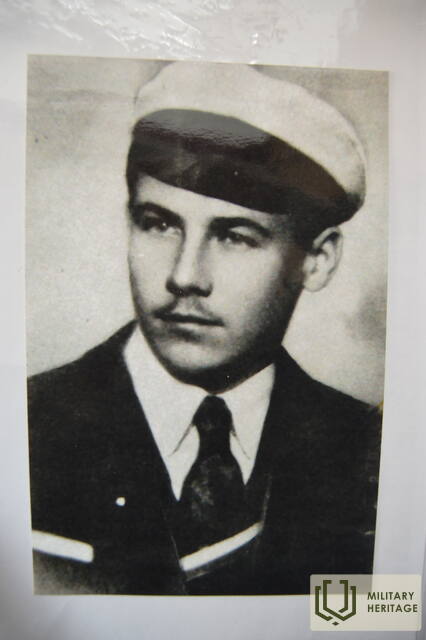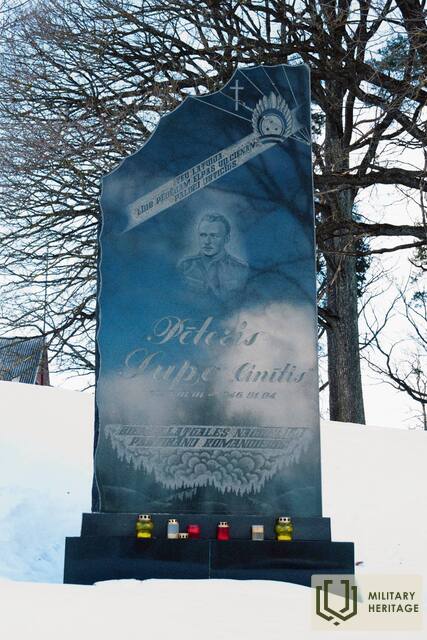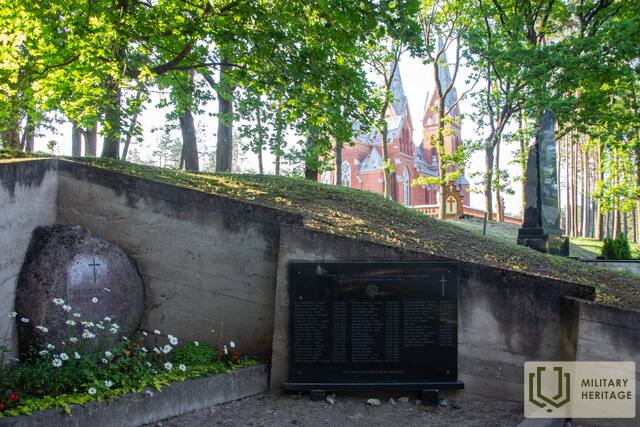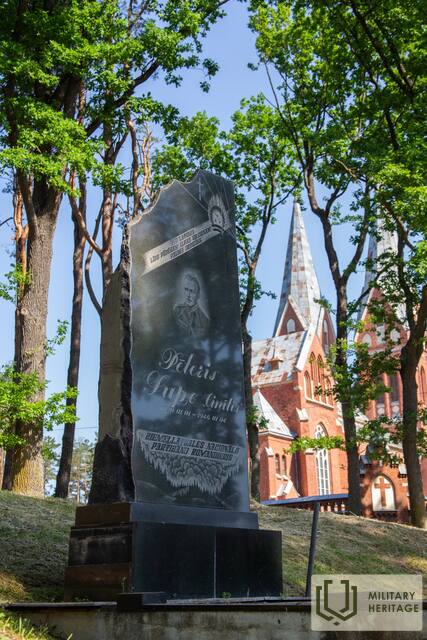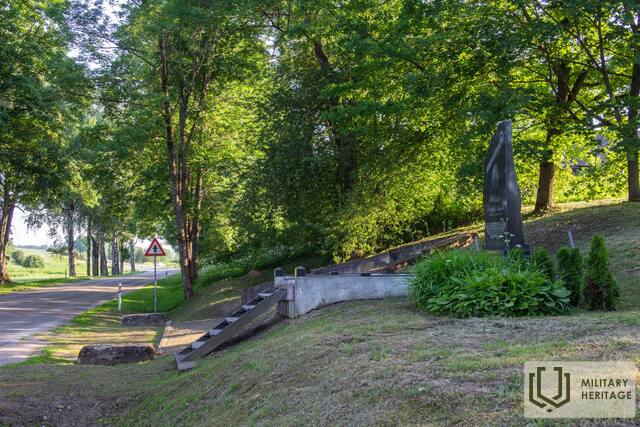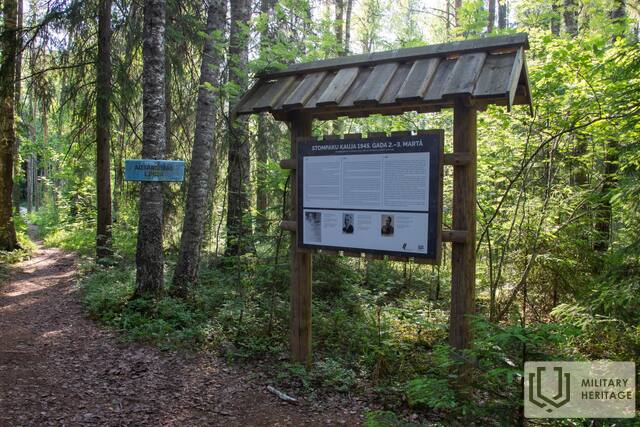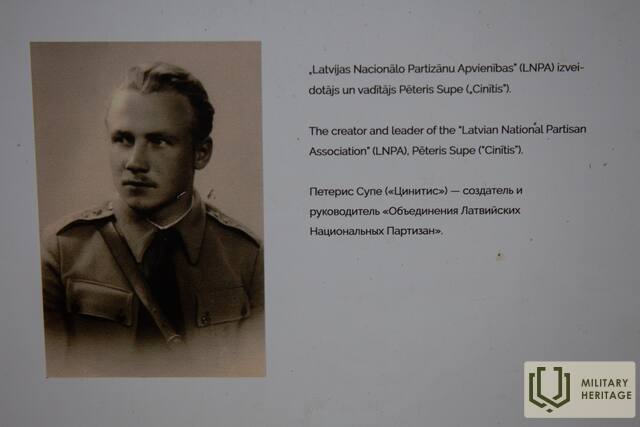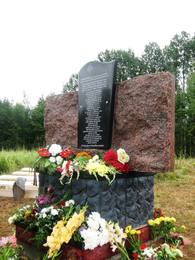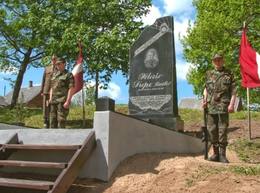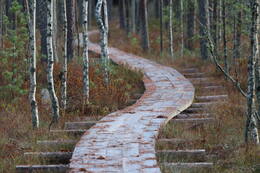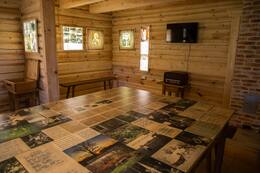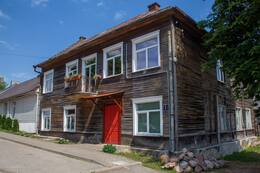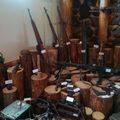Петерис Супе - инициатор создания Латвийской национальной партизанской ассоциации.
С 1944 по 1946 год Петер Супем сумел объединить разбросанные по лесам национальные партизанские отряды в организованное движение, которое в течение нескольких лет после Второй мировой войны боролось против оккупации Латвии в районе Абрене. Петерис Супе по прозвищу «Чинитис» был одним из самых выдающихся организаторов и руководителей национального партизанского движения в Северной Латгалии.
Петерис Супе родился в 1920 году в Абренском районе Пурвмальской волости, в доме нового сада. В детстве он был активным участником движения малых полков и был единственным во всем уезде, кто получил имя «Лидумниекс». В 17 лет он окончил гимназию в Вилаке, затем учился на сельскохозяйственном факультете Латвийского университета в Елгаве, а в 20 лет стал дипломированным агрономом.
Современники характеризовали его как очень предприимчивого, трудоспособного и даже в национальном масштабе фанатичного человека с хорошими талантами оратора и психолога. Во время немецкой оккупации он был главным агрономом Абренского района. Когда в конце 1944 г. советская армия подошла к Латгалии и Видземе, П.Супе бежал, чтобы вернуться на родину уже в качестве командира немецкой разведгруппы, но следует подчеркнуть, что как истинный патриот он этого не сделал. хочу служить либо немецкой, либо русской советской стороне. Немцы готовили бывшего агронома в отрядах так называемых «лесных котов» к боям за спиной противника, но П. Супе, надеясь на помощь Запада в восстановлении независимости Латвии, пошел по другому пути. В одной из первых разведывательных миссий на немецкой стороне Абрене, обнаружив большое количество латышей, призванных в Красную армию, но затем дезертировавших, он потребовал, чтобы немцы отправили оружие для формирования вооруженных групп на самолете, но получил отказ. Война не закончилась, когда осенью 1944 года Супе решил оставить службу немцам и начать организацию национального движения сопротивления.
Петерис Супе был инициатором создания Латвийской национальной партизанской ассоциации (LNPA- способность действовать до 1953 года), его заместителем был Станислав Лочмелис («Ас»), бывший студент экономического факультета Латвийского университета. Учредительное собрание состоялось 10 декабря 1944 года в лесу у села Стомпаку. У них был свой штаб, отдел пропаганды, экономики и контрразведки, суд и даже газета. На момент основания в ней было 123 человека, но уже в 1945 году, по данным военного комиссариата Вилякского района, 1000 человек, и вскоре организация перешла под контроль партизанских отрядов в Вилаке, Алуксне, Валке, Гулбене, Цесисе и частично. в Мадонском районе.
В начале января 1945 года партизаны ЛНПА по приказу П. Супе начали собираться на болотах Стомпак между Балви и Вилакой, где разбили лагерь на нескольких болотных островах, которые без преувеличения можно считать крупнейшими. партизанский лагерь по всей Прибалтике. Официальное название партизан - «Островные дома», но в народе его также называли «Новый Берлин».
Деятельность партизан П. Супезе характеризовалась бескомпромиссной войной, в которой советские активисты, сражавшиеся с партизанами, не задумываясь, были убиты. Партизаны П. Супе также выиграли знаменитую битву при Стомпаку в начале марта 1945 года, защищая свою прочно обосновавшуюся базу на островах болота Стомпаку. Это стало крупнейшим сражением за всю историю латвийского национального партизанского движения, в котором участвовали 300 солдат на стороне партизан и более 560 - на стороне СССР. Как талантливый командир, у него были все возможности постепенно превратить национальную партизанскую войну в Латвии из борьбы отдельных частей во всеобъемлющее, хорошо управляемое движение, если только 1 апреля 1946 года Петер Супи не был застрелен чехом. агент Янис Климканс. П.Супе был убит во время партизанского собрания в волости Яунгулбене, когда предатель Янис Климканс открыл огонь по П.Супе и его заместителю Хенрикасу Аусеклису (Тарауду).
Латвийские новости, 2005,
Советская оккупация Латвии, конец 1944 -50. Создание и деятельность Латвийского национального партизанского союза в период Стомпака.
Связанная хронология
Связанные темы
Связанные объекты
Памятник участникам движения сопротивления в Стомпакисе
Находится в 15 км от Балви в направлении Вилякаса, справа от дороги.
Виден мемориал.
Открыт мемориал участникам движения сопротивления, посвященный памяти национальных партизан Петераса Супеса, павших в боях 2 и 3 марта 1945 г., на обочине шоссе Балва-Виляка напротив Стомпакского болота. 11 августа 2011 года, в день памяти борцов за свободу Латвии. В конце июля в основание памятника была заложена капсула с посланием будущим поколениям. В капсулу помещен документ с именами 28 национальных партизан, павших в боях 2 и 3 марта 1945 года.
"В феврале 1945 года на островах болота Стомпаку, которые в народе стали называть островами болота Стомпаку, в 2 км от шоссе Балву - Виляка, был создан крупнейший в Латвии национальный партизанский лагерь, где проживало 360 человек в 22 землянках.Среди них несколько легионеров,которые при отступлении легионной дивизии остались со всем оружием в доме отца.Для уничтожения партизан 2 марта 1945 года бойцы двух батальонов чешских войск атаковали землянки вместе с эсминцами, которые также имели на вооружении четыре миномета.Бои шли весь день, партизаны упорно сопротивлялись, а наступающие понесли большие потери, так что не смогли захватить лагерь и уничтожить партизан.28 жителей с. Болото Стомпаку тоже пало или погибло после тяжелого ранения в бою. На следующую ночь партизаны с боем прорвали осаду лагеря и ушли непобежденными" - так считает участник движения национального сопротивления наградного отдела пишет о битве в Стомпаку председатель комиссии по делу Зигфридс Беркис.
Памятник командиру Северо-восточных национальных партизан Петерису Супу - «Чинитис»
В память о национальном командире партизан Петерасе Супесе 28 мая 2005 г. в Вилакасе был открыт памятник, посвященный ему. Он расположен возле Вилякской католической церкви, на краю вырытых во время войны траншей, где чекисты хоронили расстрелянных национальных партизан. Под памятником П. Супему помещена капсула с именами 386 павших национальных партизан, описаниями боев и материалами о партизанском командире. Слова, высеченные в камне: «Я оставался верным тебе, Латвия, до последнего вздоха».
Памятник создал Петерис Кравалис.
Рядом с ним мемориальное место в Стомпакском лесу и других местах боев борцов за свободу Латвии, павших и убитых чекистами в 1944-1956 годах.
20 июня 2008 г. на правой стене была обнаружена гранитная доска с именами 55 павших партизан, расположенными в три столбца.
Памятник установлен на том месте, где когда-то коммунистические оккупационные власти выставляли останки убитых партизан для устрашения остального населения.
На соседней табличке выгравированы слова благодарности Петерису Супе и стихотворение Брониславы Мартужевой:
«Вставай, Питер Супе,
Душа, в бой!
Сегодня Твоя кровавая жертва,
Восстал в нации.
Уходи, чтобы жить вечно
В силе и бодрости молодых,
Заворачивается, трепещет, складывается
В поднимающемся флаге!»
Деревянная пешеходная тропа, партизанский лагерь и мемориальное место на болоте Стомпаку
Болотный массив Стомпаку – особо охраняемая природная территория NATURA 2000 находится между Балви и Виляки. В восточной части болота проложена размеченная тропа протяженностью 1,5 км, пересекающая лес, а также небольшой участок высокого болота (деревянные мостки), доходящий до пяти болотных островов, на которых национальные партизаны построили жилые бункеры. По краям тропы установлены информационные стенды, рассказывающие как о здешних природных богатствах, так и об исторических событиях. Рядом с тропой есть зона отдыха. Тропу найти помогут указатели на дороге P35. В начале марта 1945 г. в лагере Стомпаку было основано одно из крупнейших национальных партизанских поселений в странах Балтии. Здесь проживало около 350-360 человек, в том числе 40-50 женщин. Начиная с января 1945 г. национальные партизаны регулярно нападали на военных и сторонников оккупационного режима. В лагере была пекарня, церковный бункер и 25 жилых бункеров – наполовину вкопанных в землю построек, где могли жить 8-30 человек.
Места расположения бункеров все еще видны и сегодня. 2-3-го марта 1945 г. здесь состоялась битва при Стомпаку – крупнейшее сражение в истории Латвийской национальной партизанской борьбы. В состав сил, воюющих против партизан, входили 2-й и 3-й стрелковые батальоны 143-го стрелкового полка 5-й стрелковой дивизии НКВД, стрелковые части (вооруженные пистолетами-пулеметами), роты минометчиков, разведывательные и саперные подразделения, а также бойцы так называемых истребительных батальонов – всего около 483 солдат.
Поэтический амбар Брониславы Мартужевой
Музей Бродиславы Мартужевой находится на месте родного дома поэтессы в Индранской волости Мадонского края. Экспозиция музея расположена в отреставрированном амбаре, где доступны аудио- и видеозаписи о движении национального сопротивления и творчестве поэтессы, издававшей подпольный журнал, писавшей стихи и песни для национальных партизан. Бронислава Мартужева участвовала в движении сопротивления с самого момента его основания.
Дом Мартужевой «Lazdiņas» (дом не сохранился) служил убежищем для главы Латвийского национального партизанского объединения Петериса Супе и его товарищей. Здесь поэтесса пять лет пряталась в подвале своего дома, встречалась с партизанами, писала стихи (в том числе посвящения партизанам: Петерису Супе, Вилсу Томсу, группе Смилга, Лайвеникису, Салнсу, Целминьшу, Бруно Дундурсу и др.), сочиняла песни и учила им партизан. Сейчас ее песни поет группа «Baltie lāči». В 1950 году совместно с Вилюсом Томасом они подпольно выпускали журнал «Дзимтене». Его 11 номеров, каждый в 10 экземплярах, поэтесса переписывала от руки. В 1951 году поэтесса, ее брат, сестра, мать и Вилис Томс были арестованы. Бронислава Мартужева вернулась из Сибири в 1956 году. Поэтический амбар стал узнаваемым как в регионе, так и во всей Латвии, его посещают как местные жители, так и гости края. Здесь есть возможность познакомиться с судьбой Латвии сквозь жизненный путь поэтессы.
Экспозиция «Комнаты Абрене» (Abrene)
Экспозиция «Комнаты Абрене» расположена недалеко от центра города Виляка. Она охватывает период с 1920 по 1960 год, когда Виляка входила в состав Яунлатгале Абренского уезда и стала центром Вилякского уезда и Абренского районов. Экспозиция расположена в здании с самой интересной и разнообразной историей в Виляке. Изначально он располагался на старой рыночной площади Мариенхаузена, позже здесь были квартиры и офисы, различные магазины, во время Второй мировой войны - штаб самообороны Латвии, гестапо, а также ЧК. В экспозиции представлены предметы, привезенные из национального партизанского лагеря на болоте Стомпаку и связанные с национальным партизанским движением в Латгалии, а также документы и фотографии, связанные с Войной за независимость. Если вы забронируете посещение в сопровождении гида заранее, то хозяин Дзинтарс Двинскис ознакомит вас со свидетельствами, входящими в состав экспозиции.
Музей национального движения сопротивления в Ренде
Музей расположен в нескольких километрах от центра Ренды. Выставка рассказывает о движении сопротивления в Латвии, которое длилось 50 лет: сопротивление первой советской оккупации, сопротивление оккупации нацистской Германии, вооруженное и ненасильственное сопротивление советской оккупации. Экспозиция расположена в двух зданиях. В первом здании можно осмотреть свидетельства первой советской оккупации и немецкой оккупации. В отреставрированном здании амбара экспозиция посвящена национальной партизанской войне. Между двумя зданиями находится бункер с аутентичной планировкой и траншеями, по которым перемещались солдаты. Рядом с музеем в Ренде находятся траншеи, блиндажи и полоса препятствий как тренировочная площадка для Яунсардзе и других желающих. Посещение необходимо бронировать заранее.
Рядом с этим местом в январе 1946 года произошло одно из крупнейших сражений национальных партизан, получившее название битва при Апузниеки, в котором группа национальных партизан Кабиле одержала победу над существенно превосходящими её оккупационными войсками. На месте боя оборудована зона отдыха и установлены информационные стенды.
Музей Вилака. Выставки о военном наследии в районе Виляки
Музей Виляки работает в двух зданиях – католическом приходском доме, построенном в 1913 году, который является важным объектом культурного наследия города, и другом здании музея – бывшем монастыре монахов-капуцинов, подвалы которого тесно связаны с национальным партизанским движением в Стомпаки и советской ЧК. По воспоминаниям местных жителей, в этих подвалах содержались и подвергались пыткам люди. В старом здании музея размещено несколько экспозиций, одна из которых посвящена освободительным боям 1920 года в Северной Латгалии, а вторая – событиям Второй мировой войны – еврейскому Холокосту в Виляке и информации о расстрелянных семьях. Более подробная информация о каждой семье доступна по ее адресу.
Экспозицию дополняет информация о национальном партизанском движении в Стомпаки – различные свидетельства, фотографии и предметы. Посетители могут узнать о военных объектах наследия в Виляке и ее окрестностях, таких как Памятник борцам за свободу в Яшкове, который был снесен в советское время и восстановлен в 1990 году, и стела, посвященная кавалерам ордена Лачплесиса. В экспозицию музея включен звук самолетов Второй мировой войны, поскольку немецкий аэродром Люфтваффе находился недалеко от Виляки. Музей дает возможность увидеть некоторые воспоминания о событиях Второй мировой войны в Виляке, а также получить информацию о немецком лагере для военнопленных в Рачи




